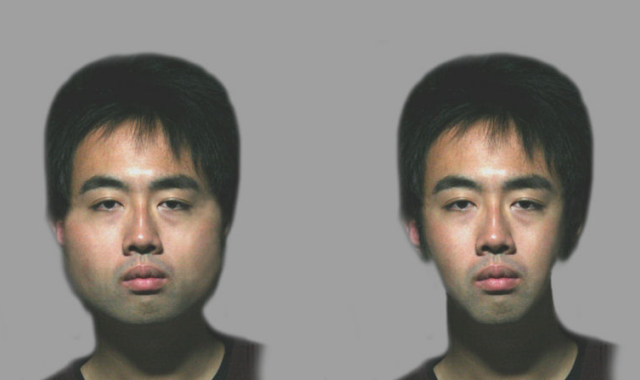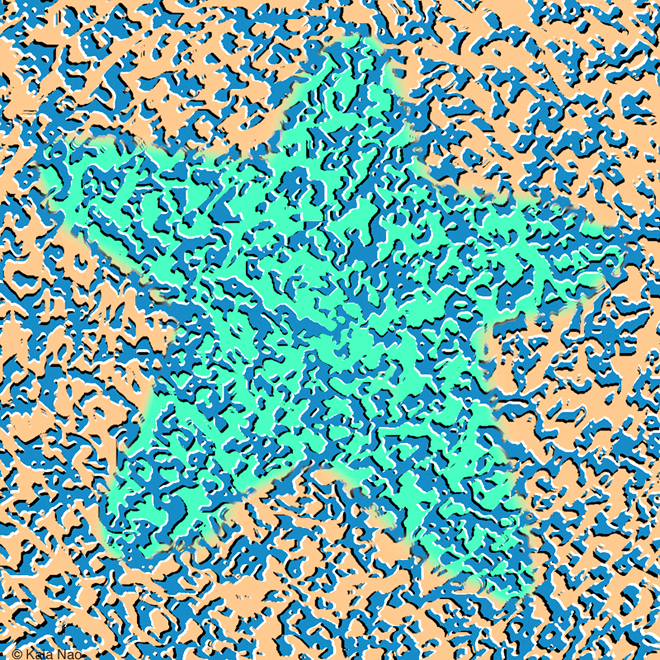This multi-sensory illusion uses vision, touch and position sense to create the illusion that the hand has disappeared. The felt positions of the hands are gradually adapted without the participant noticing so that the real locations of the hands end up further outwards than their perceived locations. When the right hand is removed from vision and the participant reaches across to touch it, all they can feel is the empty table. The combined loss of vision and touch creates a powerful illusion that the hand is missing and was designed to simulate loss of awareness in stroke patients.
When Pretty Faces Turn Ugly: The Flashed Face Distortion Effect
When you stare directly at the faces, they look normal. But, if you stare at the cross, the faces quickly turn ugly.
Like many interesting scientific discoveries, this one was an accident. An undergraduate student was working on face photographs for an unrelated experiment when he was suddenly shocked by the deformed faces staring back at him.
The distortion comes from the many differences between each face and the one that follows. A particularly tanned face, for example, will make the next face seem pale and squinty eyes will make normal eyes bulge.
More info here: mbthompson.com/research
The colored dot/peripheral vs. central vision
You will see that the spots move along straight horizontal paths. But now look at it in peripheral vision – look away, but attend to the movie out of the corner of your eye. The paths of the spots now appear to be bent, in the direction of the background stripes. In this example, the spots move around in a circle. But in peripheral vision they appear to slide vertically when the background stripes are vertical, and horizontally when the stripes are horizontal.
Head Size Illusion

Which person needs a bigger hat to fit his head? Of course, the fat person appears to have a bigger head than the thin person. This impression is especially pronounced if you look at the face rather than the head. Actually, both persons can wear a hat of exactly the same size because they are identical except the width of cheeks, jaws and necks. Importantly, this illusion is occurring in our daily life! Perception of a body part is influenced by other parts. Makeup, hairstyling, and clothing can take advantage of this kind of illusion to make you look better.
Floating Star

The peripheral drift effect is applied to a random pattern to give the illusion of motion in different areas of an underlying figure, in this case a star. The random quality of the pattern tends to minimize interference between the elements of the image that generate the illusion of motion and the interpretation of the overall figure. The technique could possibly be used to “animate” illustrations of phenomena such as fluid flow, flux lines, or weather patterns.
Exorcist Illusion – Twisting Necks
The “Exorcist illusion” is a tricky variation of the hollow-face illusion. We rigidly fused a concave mask and convex torso and vice versa (a challenging sculpting task around the neck). We then painted these rigid “statues” realistically and rotated them. Even though they have no moving parts, they create a compelling paradoxical illusion of twisting necks! The torso rotates in one direction and the face rotates in the opposite direction; thus the neck twists in a strange fashion, similar to the “Exorcist” movie (1973). Also, if a viewer moves in front of the statue, the neck appears to twist dangerously.
Peripheral Action Phantom Illusion
In this illusion, we created an animation of human walking out of oriented Gabor disks. The disks were spatially configured to reflect the joint movements of a leftward walker. Indeed, when viewed directly most people report seeing leftward walking. However, when viewed peripherally (red fixation cross) a phantom action appears as the walker suddenly changes walking direction! The reversal occurs because the local features of the disks (orientation, drifting speed) were carefully manipulated to instead represent a rightward walker. Additional demos are available (e.g. “chicken dance”) showing other peripheral action phantoms using the same general paradigm (link).
Attentional modulation of perceived color
Attention can influence the color that you perceive. In the moving case, one disk moves. This brings your attention to it, and you see the whole disk as having a uniform color.However, the middle region in fact always remains gray. This means that you sometimes see a gray region as part of a uniform blue, red, yellow or green object! (If you can”t see the animation you will need to download and install the Shockwave plugin).
This also works when you attend to a single figure in a static drawing. In the case of the static three disks, fixate the central fixation spot and then attend to one disk. The whole disk will appear to take on a uniform color. Attend to a different disk, and it will take on a different color, even though the middle overlap region always remains gray. The same goes for the case of overlapping rectangles. Attend, for example, to the blue rectangle, and the whole rectangle will appear blue. Now, attend to the other rectangle, and the whole rectangle will take on a different hue, even though the overlap region remains gray in every case.
Illusion of Height Contradiction
Impossible objects are mental images of solid objects which cannot exist in a real 3D space. So , when looking at them in 3D space, the viewing point must be confined to just one fixed angle and apparent structure of them doesn’t accord with the real structure.
Here, a new unique method is used to make impossible objects . The balls’ motion on the impossible objects of the height contradiction accords with the direction of gravity. The models made from corrugated paper and a polystyrene board in real 3D space. No CGI , no video manipulations except explanation use.
